
archives for 11/2015
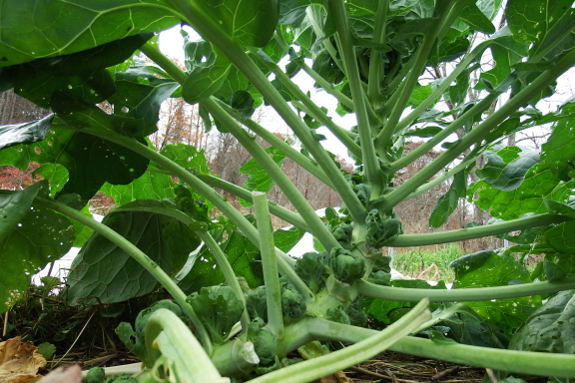
We've only been growing
brussels sprouts for a few years, so I'm not surprised that I'm still
working the kinks out of our system. This looks to be a good year for
them...but I can't take credit for the success. Because the big,
beautiful plants like the one shown above were purchased at the beginning of August as already good-looking sets.
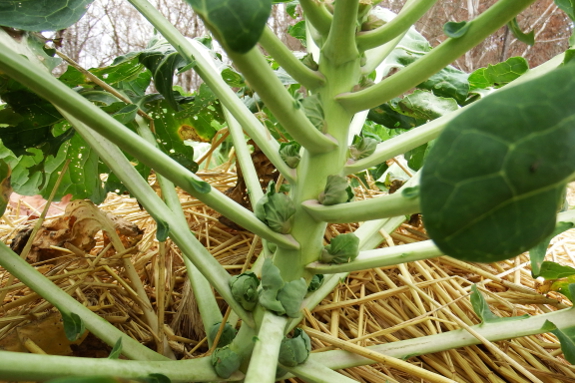
In contrast, my
best-looking homegrown plant is running about a month behind. If we have
a mild late fall, we'll get a good crop from this bed, but a harsh,
early winter could just as easily wipe these plants out before they
bear.
Moral of the story: start
brussels sprouts earlier than you think you need to. I'd say the
beginning of May would have been about right in our neck of the woods.
This Lucas power steering stop leak fluid did not stop our small leak but slowed it down enough to make it worth the purchase.
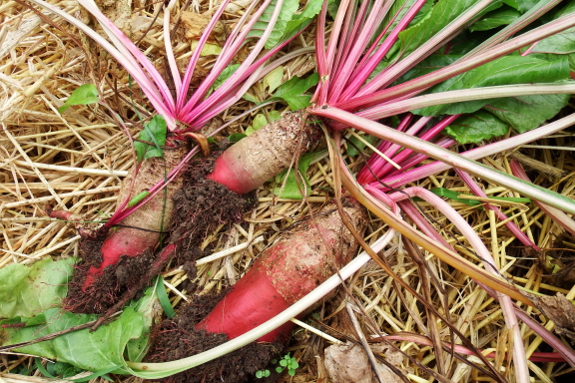
It's getting on toward
the end of the rye-planting season, which meant I needed to make a
decision about that bed of big, beautiful mangels. The trouble is, my spoiled goats refused even an aged root this week. And my unspoiled mother politely turned down a second helping of the fodder beets. I guess they're going on the compost pile!
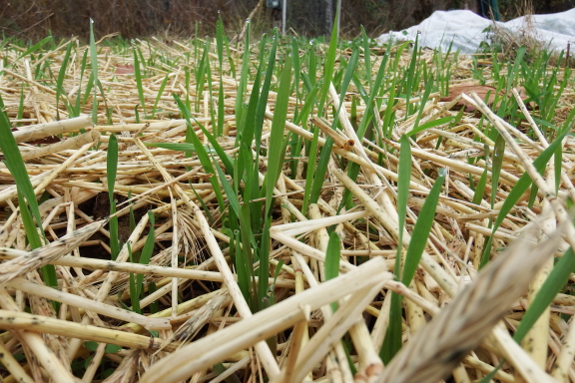
When might mangels be a good fit for your homestead? Less finicky livestock --- like cows and sheep --- might eat them. And I also wonder if they might not work as a soil-improving cover crop a bit like oilseed radishes.
But, for now, I'm moving mangels onto the list of "tried it once, won't
try it again." At least I got some pretty pictures out of the
experiment!
We've been letting our
chickens free range in the floodplain lately.
The problem is they figured
out how to go all the way around to the west gate entrance and sneak
into the garden when we're not looking.
A new Lucy
door and some plastic to block the bottom fixed it nicely.
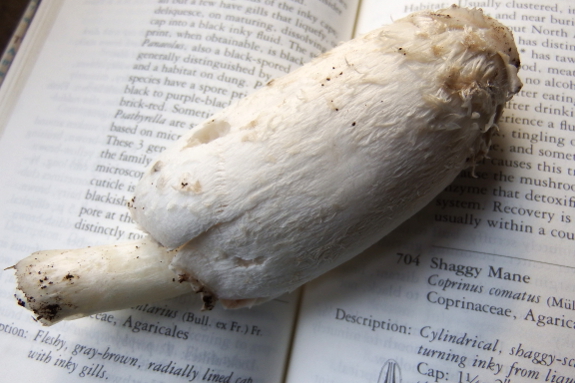
A few readers have asked
how we manage to eat wild mushrooms without killing ourselves. Since we
added a new species --- shaggy mane --- to our repertoire this week, I
thought now would be a good time for some fungal wildcrafting tips.
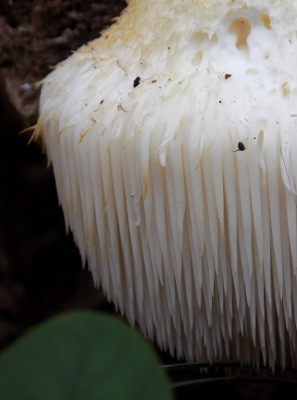 First
of all, when I'm out in the woods, I only select the really easy
edibles, species that are awfully hard to confuse with anything
poisonous. After reading a few mushroom books and websites and hanging
around with mushroom hunters, you'll hear the same names pop up over and
over. Morels, oysters, chicken of the woods, hen of the woods, chanterelle, lion's mane,
shaggy mane. These species are all pretty unique and have few or no
poisonous lookalikes. You'll notice, though, that I steer clear of even
prime edibles that are just plain old gilled fungi since they're too
easy to confuse with deadly species like amanitas.
First
of all, when I'm out in the woods, I only select the really easy
edibles, species that are awfully hard to confuse with anything
poisonous. After reading a few mushroom books and websites and hanging
around with mushroom hunters, you'll hear the same names pop up over and
over. Morels, oysters, chicken of the woods, hen of the woods, chanterelle, lion's mane,
shaggy mane. These species are all pretty unique and have few or no
poisonous lookalikes. You'll notice, though, that I steer clear of even
prime edibles that are just plain old gilled fungi since they're too
easy to confuse with deadly species like amanitas.
After finding one of
these easy mushrooms, I bring it home and look it up in at least two
sources. I have three mushroom field guides on my shelf and the internet
offers many additional photos and descriptions. There, I learn
warnings, such as the shaggy mane's ability to make you sick if you're
consuming alcohol that day or chicken of the wood's requirement for
thorough cooking. At the same time, I check distinctive field marks. In
this case, Mom and I had seen an older shaggy mane in the same spot
Friday that was mature enough to be disintegrating into the typical
black goo. Finding a younger mushroom that looked the same a few feet
away and a few days later made this a pretty safe ID.
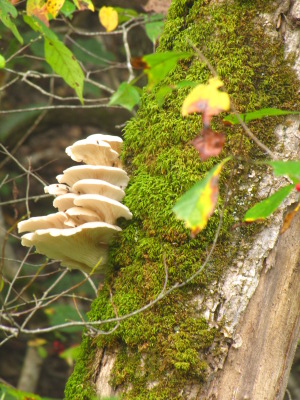 Next,
I restrain our enthusiasm and cook up only about a tablespoon of the
mushroom for our first meal. With a few exceptions, most poisonous fungi
aren't so strong that they'd kill us at that level of consumption. So I
figure the worst we'd have to put up with would be a round of stomach
upsets. That said, I often experience psychosomatic symptoms after
eating the test fungi, but Mark is less suggestible and doesn't get
them. I know the symptoms are psychosomatic because they promptly go
away when I get busy doing something else....
Next,
I restrain our enthusiasm and cook up only about a tablespoon of the
mushroom for our first meal. With a few exceptions, most poisonous fungi
aren't so strong that they'd kill us at that level of consumption. So I
figure the worst we'd have to put up with would be a round of stomach
upsets. That said, I often experience psychosomatic symptoms after
eating the test fungi, but Mark is less suggestible and doesn't get
them. I know the symptoms are psychosomatic because they promptly go
away when I get busy doing something else....
Then, for the next meal,
we gorge! Delicious, found fungi from our own woods --- what could
be better? (And, in case you're curious, the shaggy mane was about
equivalent to an oyster mushroom in flavor --- good but not
outstanding.)
In the end, I feel like
harvesting your own edible fungi using this method is actually safer
than eating store-bought food. I've wildcrafted quite a few mushrooms
and have never gotten sick, while I've had food poisoning from off-farm
food multiple times. So which is really more dangerous --- eating a
shaggy mane or buying that hamburger from McDonald's?
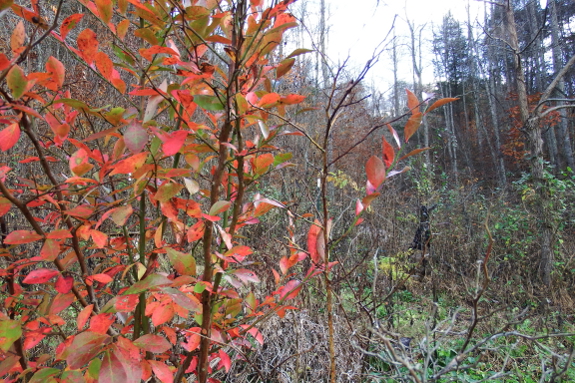
Indian Summer is the
perfect time to weed, feed, and mulch woody perennials for the year.
We've already had a week of killing freezes, so topdressing with compost
now won't tempt our bushes and trees to put out new growth that will
get nipped by winter cold. On the other hand, perennials' roots are still reputed to be quite active at this time of year...and will stay active even longer if sheltered with some insulative mulch.
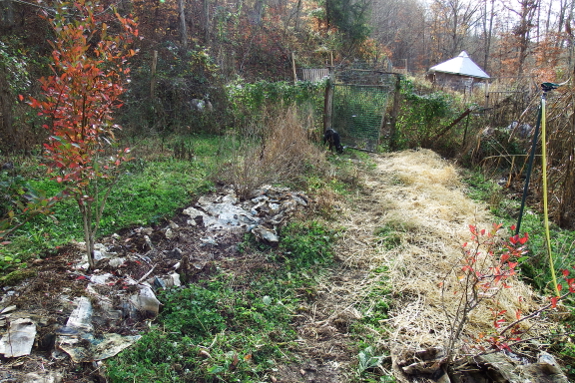
So while the weather is
warm enough to make pushing my fingers into rich, black dirt a pleasure,
I'm weeding the perennials as fast as I can. But I spared a moment to
spread rye seeds and a light coating of straw in areas where I'd ripped
out winterkilled rabbiteye blueberries.
The soil there is chockful of organic matter due to years of
topdressing, and I haven't quite decided what will eventually fill the
empty beds.
What's next? I've still
got quite a bit of weeding left to get the perennials in order. But
after that I'll block off sprouting weeds with a thin layer of
newspaper, then hold that down with deep bedding from the goat or
chicken coop. A similar round of kill mulching (anchored by pulled weeds
that time) in early summer made the fall weed-and-feed expedition much
simpler. Here's hoping the winter round holds up as well.
It takes over an hour to drain and wrangle our garden hose collection.
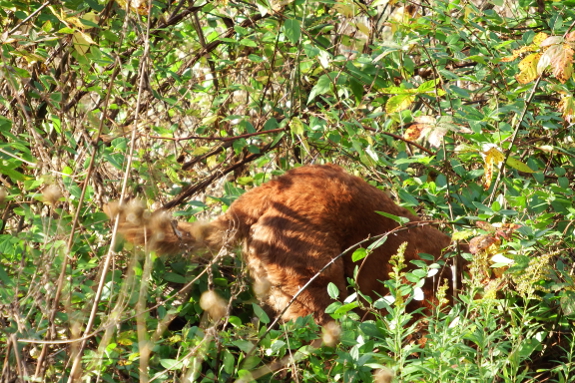
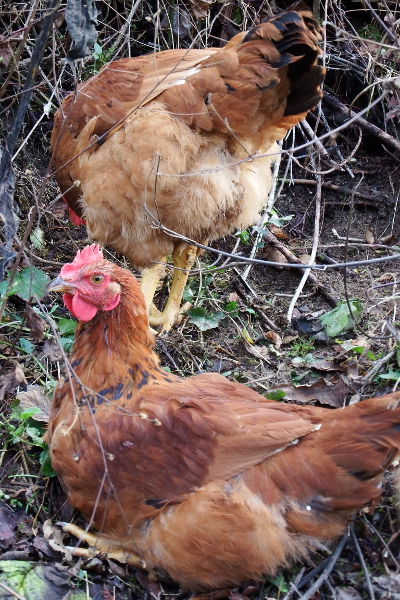 I
set out with the goal of taking a photo of each animal on our
homestead. But I got sidetracked about halfway through, so no shots of
our comatose cats (2), our busy bees (uncountable hundreds), or our
happy hens (11).
I
set out with the goal of taking a photo of each animal on our
homestead. But I got sidetracked about halfway through, so no shots of
our comatose cats (2), our busy bees (uncountable hundreds), or our
happy hens (11).
Our dog usually gets top
billing, but she wasn't particularly keen on playing along today. She'd
had her head in a brier patch barking at a snake or rodent for about two
hours, and she told me she couldn't stop working for the sake of fame.
So I'm afraid all you get is a Lucy butt.
Our broilers,
though, were more amenable to the idea since they're nearly mature and
tend to nap through most of the afternoon. So far, I'd say Red Rangers
seem like a good compromise between the scrawny heirloom broiler and the
lazy Cornish Cross. They do eat like crazy, with sixteen birds going
through about fifty pounds of feed per week. But they're also energetic
enough to walk up the hillside away from their coop to scratch through
the leaves...at least from time to time. The real test will come in two
weeks when we kill and pluck our first bird, but for now I'm happy with
how Red Rangers act on the "hoof."
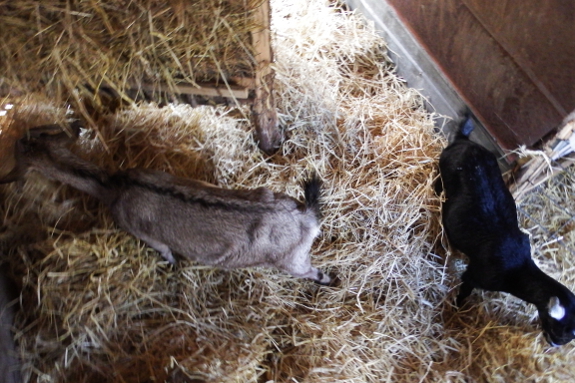
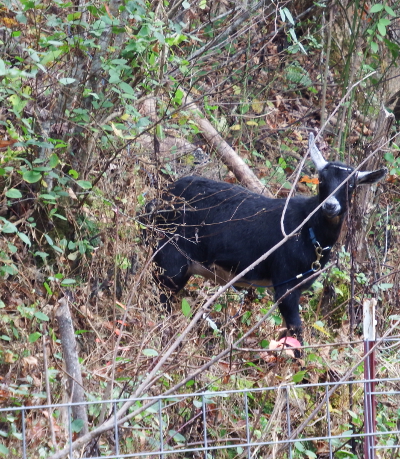 Meanwhile, in the goat barn, our ladies were busy picking through the fresh bedding I spread after stealing their soiled straw for the blueberries.
Previously, I tethered our herd outside, which is always a bit of a
puzzle. Where can I attach their leashes so the goats will have plenty
to eat (which at this time of year means oats and honeysuckle), where
they can't get too tangled, where they're close enough to see each other
but not to get their leashes tied together, where they can't eat my
perennials, and where Artemesia doesn't feel like she's so far away from
me that she has to be on high alert rather than chowing down? My
original hillside option was a dismal failure, so we compromised on the
honeysuckle-coated fenceline right beside the blueberry patch.
Meanwhile, in the goat barn, our ladies were busy picking through the fresh bedding I spread after stealing their soiled straw for the blueberries.
Previously, I tethered our herd outside, which is always a bit of a
puzzle. Where can I attach their leashes so the goats will have plenty
to eat (which at this time of year means oats and honeysuckle), where
they can't get too tangled, where they're close enough to see each other
but not to get their leashes tied together, where they can't eat my
perennials, and where Artemesia doesn't feel like she's so far away from
me that she has to be on high alert rather than chowing down? My
original hillside option was a dismal failure, so we compromised on the
honeysuckle-coated fenceline right beside the blueberry patch.
Not counting the
honeybees, that's thirty-two lives depending on our daily attention.
Some days, it feels a bit like I'm running a kindergarten.
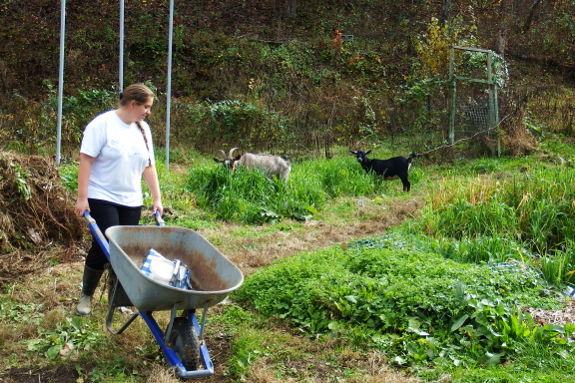
I always save my very
worst, nitpicky weeding jobs for when Kayla's coming over. That bed on
her left? I'm growing strawberries there, not chickweed...supposedly.
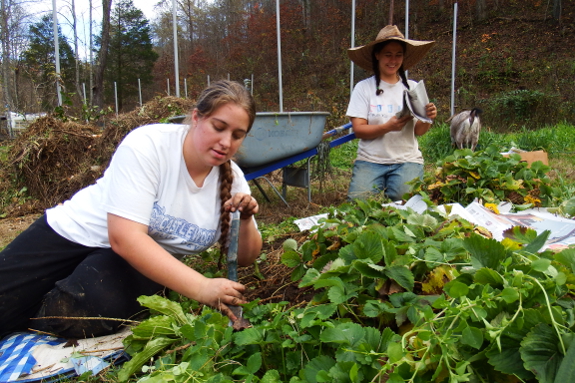
We chatter away, but still manage to get a lot done...although apparently not enough to keep our feline supervisor happy.
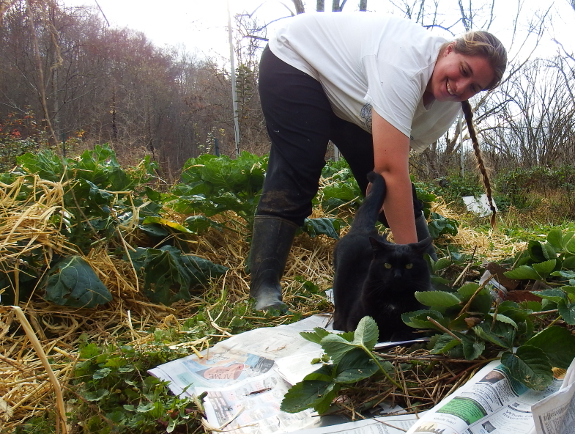
"Hey, is this a hen party
or a work session?" asks Huckleberry. He cracks the whip...then sits
down on the newspaper so we have to expend twice as much energy to work
around him.
Thanks for braving the yellow jackets, the ornery cat, and the
enthusiastic goats, Kayla! We'll look forward to seeing you again next
week.
I did some tests today to see
if a Dynamic microphone could be used in place of a condenser
microphone for a boom pole application.
The results say it's a bad
idea. Not loud enough for the distance needed even when the levels are
boosted.
I'm using a Zoom
H4N to record synchronized sound with a classmate's DSLR camera.
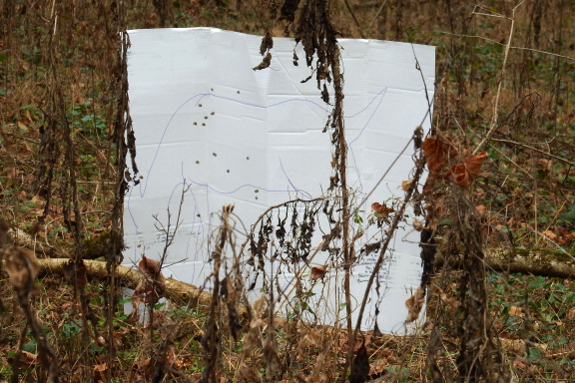
Last year, the acorns
fell on the hillsides and the deer stayed out of our valley. But we've
had lots of deer sightings this fall already. So I'm hoping to snag one
of the three does who have been occasionally making their way into the
garden.
First step --- pay
attention to their patterns. Due to goats, my usual spot (which allowed
me to "hunt" from the couch) no longer sees much deer activity. Instead,
I've been spotting the nibblers mornings and evenings on the other side
of the chicken pastures when I go to check on our flock.
Friday, Mark helped me
set up a cardboard deer around where I've been sighting the real ones.
Then I blew through a bunch of bullets to remember that I need to aim a
little above and to the right of my sight and that I do better if
leaning against something solid (like the coop) to brace myself against
the gun recoil.
All told, I bagged that cardboard deer a little over half the time. Here's hoping the real event goes as smoothly.
This is how we block mice from entering the Warre hive during the Winter season.
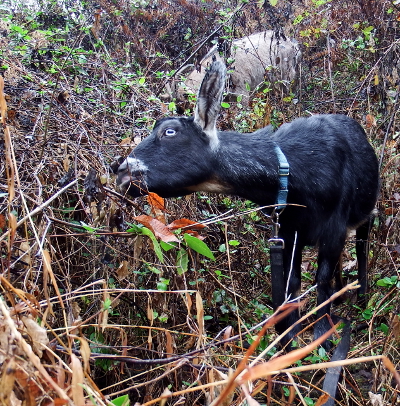 "Which one is supposed to be pregnant?" Mom asked when she came by a week ago.
"Which one is supposed to be pregnant?" Mom asked when she came by a week ago.
"Artemesia," I replied, pointing to our plump little doeling.
My mother, who knows very little about goats but plenty about pregnancy smiled indulgently. "No."
Saturday, Mom was proven
right when Artemesia finally came into heat. I'd started waving the buck
rag in her face every morning four days prior, which may or may not
have jumpstarted the estrous cycle. No matter the cause, Artemesia
seemed uninterested in grazing Friday, Saturday morning her normal tail
wag looked a lot more like flagging when I pressed down on her butt, and
Saturday afternoon mucous finally appeared on her vulva. Then she
started yelling --- she was raring and ready to go.
With 20/20 hindsight, I'm
now thinking that our doeling's loss of fat in late summer was due to a
mild parasite infestation rather than to using extra calories to feed
an unborn kid. At the time, I knew that was one of the possibilities, so
I dosed both girls with garlic and squash seeds and also increased
Artemesia's rations a bit. Now she's as plump as ever, verging once
again on slightly too fat.
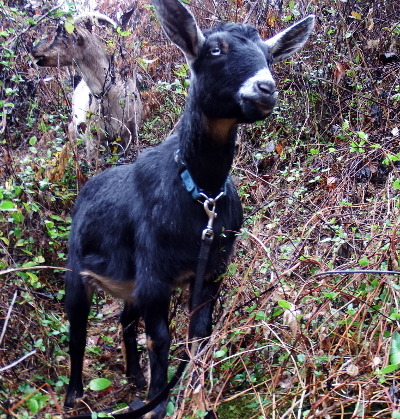 I
expected to be disappointed if no kids came popping out in early
November, but I'm actually relieved. The cold spell we experienced a few
weeks ago pointed out two things that were probably obvious to the rest
of you about winter milking. First, your fingers will freeze, which is a
no-no for keeping my carpel tunnel in check. Second, Abigail's milk
became considerably less creamy during a rainy week when she was
subsisting mostly on hay, suggesting that winter milk might not be the
holy grail after all.
I
expected to be disappointed if no kids came popping out in early
November, but I'm actually relieved. The cold spell we experienced a few
weeks ago pointed out two things that were probably obvious to the rest
of you about winter milking. First, your fingers will freeze, which is a
no-no for keeping my carpel tunnel in check. Second, Abigail's milk
became considerably less creamy during a rainy week when she was
subsisting mostly on hay, suggesting that winter milk might not be the
holy grail after all.
But spring milk --- I
definitely don't want to miss out on that! So it's time to get back on
the ball about tracking down a buck to provide stud service. Since the
chances of me finding a mate for Artemesia today are slim to none, that
means her sex life is going to complicate my first experience hosting a
full family Thanksgiving. I can see the explanations to my grand-niece
and -nephew now. "Sorry, Auntie Anna has to go make sure her goat has a
good time...."
The other thing that failed
on my low
budget boom pole test was this modified microphone holder
fabricated with two brackets and a washer.
I was trying to see if I
could get by without installing a proper shock mount.
Turns out this configuration
tended to pick up way too much pole noise.
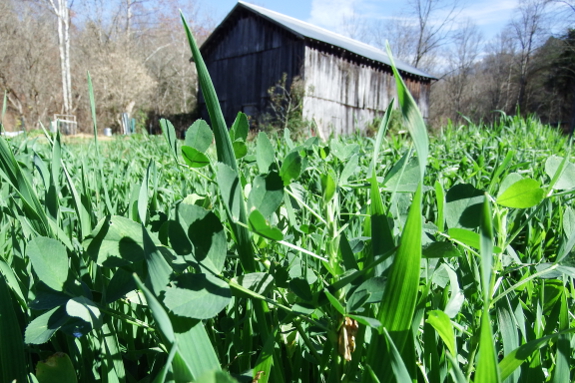
Colin Seis and Darryl Cluff are the modern experimenters who have revived the concept of pasture cropping
in Australia. Basically, the idea is to grow grains in existing
pastures without tilling, presumably by first grazing or cutting the
pasture grasses very low during their dormant season, followed by
drilling grains into the stubble. The annual grain is able to grow
faster than the sleepy perennial grasses, but the latter survive well
enough to regrow once the grain produces seed and is harvested.
I have neither excess
pastures nor a wish to grow vast amounts of grain. However, our goats
adore oats as a fall and early winter forage plant. And I also wondered
whether planting oats in some unused corners of our core homestead would
push back the weeds well enough to let me seed other goat-friendly
plants there in later seasons. So in early to mid September, I begged
Mark to weedeat some experimental areas to the ground, I sprinkled on
oat seeds (along with a bit of alfalfa), then I scattered a thin layer
of straw on top to keep birds at bay. Finally, I sat back and I waited.

To my surprise, my
experiment appears to have worked! Now, granted, the oats have grown at
about half the rate of those in well-loved garden beds, which means the
goats turn up their noses half the time at the lawn-grown oats. But if
we don't get a serious cold spell in the next month, I suspect the
slower oats will get stemmy enough to strike Abigail's fancy and that
she'll be glad of the late forage. (If I had it to do over again,
though, I'd plant the lawn oats a week earlier than the garden oats
rather than a week later.)
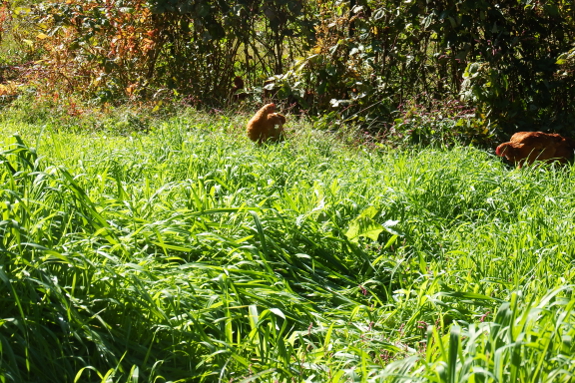
And we've actually already fed one round of animals via lawn cropping. Our Red Ranger broilers
started expanding their foraging runs into the oat pasture by the time
they were four or five weeks old, which just happened to coincide with
the oats being at their most tender and succulent. As a result, the
grains closest to the brooder were pecked down nearly to the ground,
although the plants quickly bounced back once the broilers were moved to
a grownup coop. I don't know whether its the extra sun this spot gets
or the addition of chicken manure, but these oats are growing twice as
well as the bed I photographed earlier in a no-chicken, shady spot.
The big question now is
--- what will these lawn cropped areas look like come spring? Will the
grasses pop back up, or will the ground be bare enough to try seeding
some soybeans for soil nitrogen and summer goat protein? I'll keep you
posted!
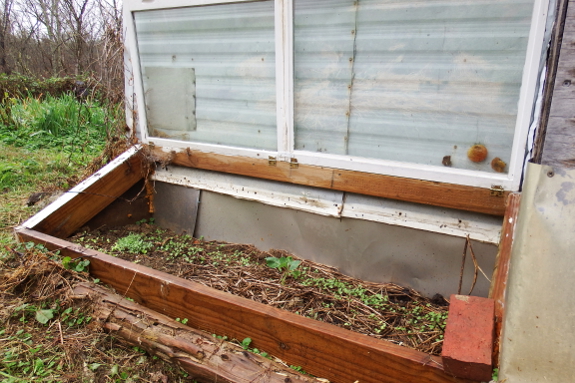
I had big plans when we made our cold frame this spring. But the plans got derailed by realizing that the house-side location makes the bed much shadier than plants like.
Plus, I forgot to add the cold-frame to my garden spreadsheet, so its
contents didn't get planted when I seeded winter greens in the main
garden.
But when I pulled out the
tomatoes, I figured I might as well toss down some lettuce, kale, and
arugula seeds. So I'll get to see how late-planted greens do in the cold
frame as opposed to those planted at a regular time and shielded by quick hoops in the sunny mule garden. Soon we'll see if the glass is enough to let these tender morsels mature during winter's cold.
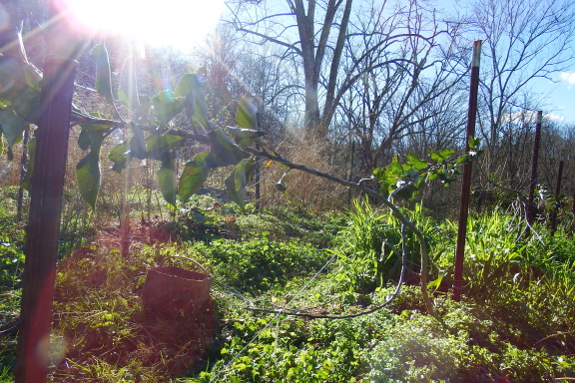
Our high-density apple experiment
has been 80% successful. The technique has allowed me to grow lots of
varieties in a small space, tricking them into blooming at a young age.
The only problem? Due to our frost-pocket location, those blooms get
nipped most springs, so we don't get any fruit.
So I'm veering off in another direction with my next round of experiments. Espaliered trees
are trained to be two-dimensional and relatively short, so it's much
more feasible to cover them during late-spring frosts. The only question
is --- is MM111 rootstock too vigorous for espaliering? I went ahead and bent last year's graftees down
along wires and am prepared to deal with lots of watersprouts if they
pop up. Perhaps keeping fertilization to a minimum and summer pruning
relentlessly will do the trick.
We're experimenting with a new type of PVC moveable greenhouse structure.
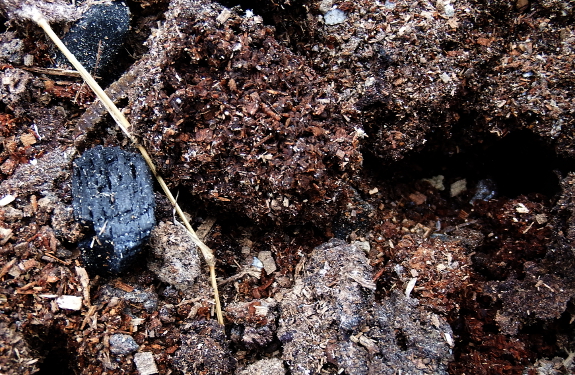
Last week, I started dipping into another source of garden fertility --- humanure. During our first application, we applied waste that had been composting for eight months,
and I felt it could have been a bit more decomposed. So this time
around, we waited a full fifteen months and the humanure was rich and
beautiful. In fact, if I hadn't known where it started, I would have
been tempted to plunge my fingers into the compost and smell it like any
other rich earth.
The other change was that I tossed the year's biochar down the hole last fall too. The idea there is to more perfectly recreate terra preta,
which merged human waste, charcoal, and other types of debris. It's
hard to tell which part of the terra-preta process produces the
near-magical results, but it certainly can't hurt to inoculate my
biochar with humanure.
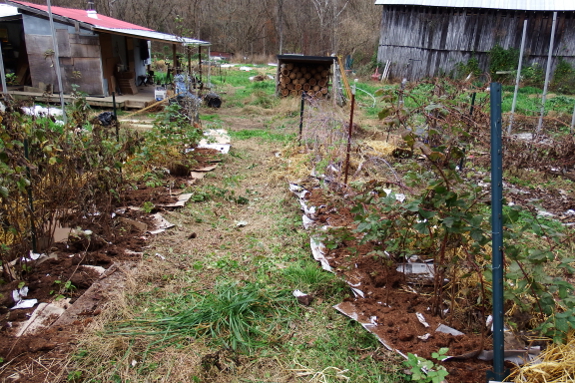
This year, I also decided
to run a side-by-side experiment to see how the humanure compares to
chicken-manure bedding from the broiler coop. To that end, I laid down
newspaper and cardboard as a kill layer around three rows of front
berries, then sprinkled half of each row with humanure and half with
chicken manure. I'll be curious to see which berries taste sweeter come
June.
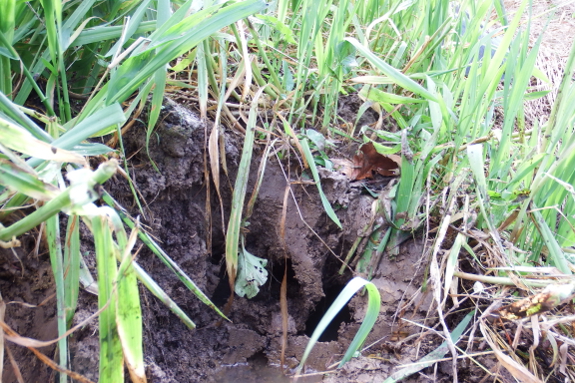
Two years ago, I started
dealing with the half of our core homestead that's severely waterlogged.
My solution was simple --- build high raised beds that pull the root
zone out of the swamp. In two areas, this technique worked like a charm, but the lowest point
(our gully) was simply too damp. As you can see in the photo above, the
water table stays about five inches below the top of the beds in this
area, and crawdads moved in to build tunnels yet closer to the surface.
After two years of watching summer crops perish due to wet feet, I
decided to move on to plan B.
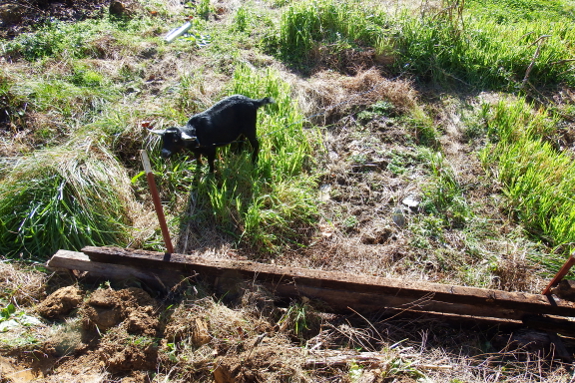
We don't have enough
sunny spots that we can waste any, so I decided to move all of the good
soil out of the gully beds and into one large terrace along the
south-facing bank of the gully. In the past, we've had good luck using fence posts and rotting wood from an old house we tore down to make terraces elsewhere,
so I replicated the methodology in this spot. The wood will eventually
rot away, but by then tree roots will be holding the soil in place.
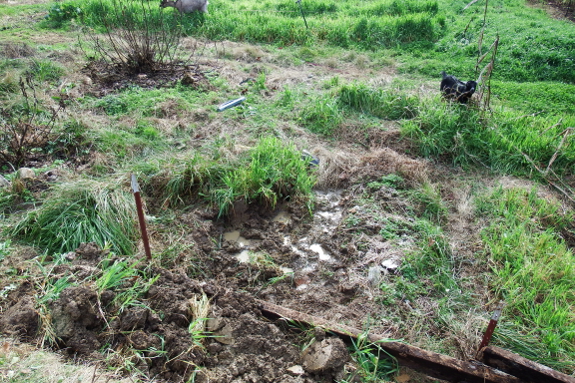
There was just enough
soil in the gully beds above water level to fill the terrace. Actually,
there's still quite a bit of rich dirt left behind, but I'll have to
wait until the dry season to excavate it. Wet dirt is heavy! Then, once
that's done, I'll either plant the denuded gully area in cattails to
create a wetland or try to dig it deep enough to make a little pond.
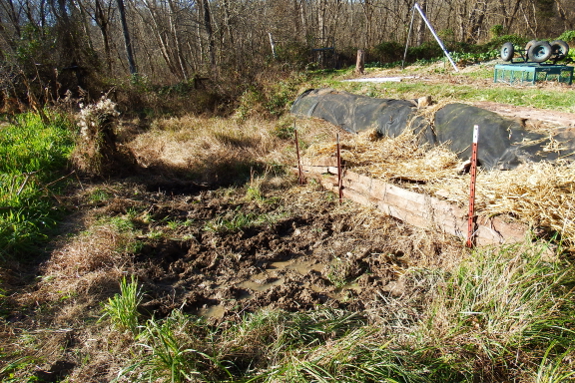
In the meantime, my focus remained trained on the new terrace. I had a good length of woven, 10-year plastic leftover from summer experiments,
so I laid it along the side of the gully behind the new terrace to keep
this area weed-free. I suspect if I want the plastic to really repel
weeds for a decade, though, I'll need to block the sun somehow. Perhaps
creeping phlox (the local choice for this application) or thyme planted
in holes in the weed barrier will suffice?
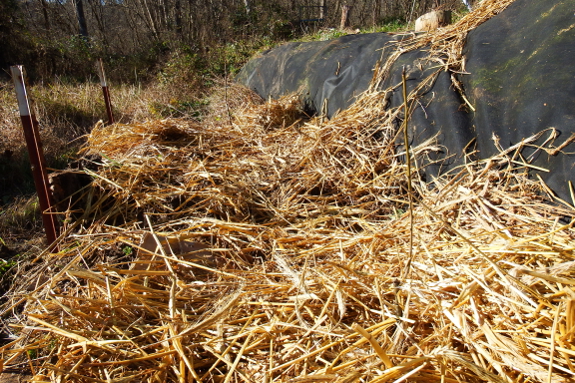
For now, though, the terrace is good enough as-is. So I set out three dwarf pear trees that I grafted this past spring,
watered them in with black-soldier-fly leachate, then kill mulched the
babies with cardboard and straw. Here's hoping the saplings get their
feet under them quickly and grow!
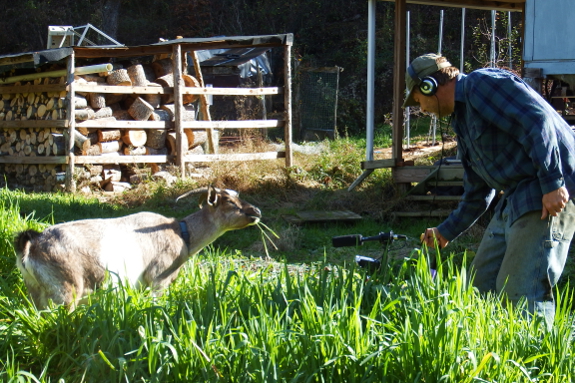
Abigail helped me test out
the new VidPro
XM-55 unidirectional condenser microphone.
The quality is a huge step up
from the built in mic on my Canon FS200A camcorder.
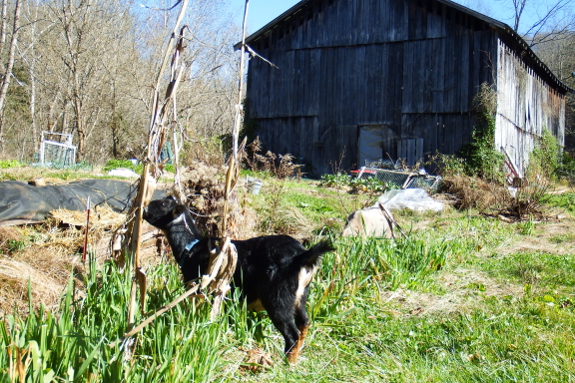
Goat owners often dry off
their goats two months before the next kids are due...assuming they
feel confident milking that long. Alternatively, you can stop milking
when you think your doe is getting too skinny
or when your fingers start getting too cold. Or, in our case, when
you're sure your other doe isn't pregnant and won't need a backup milk
source just in case the worst happens.
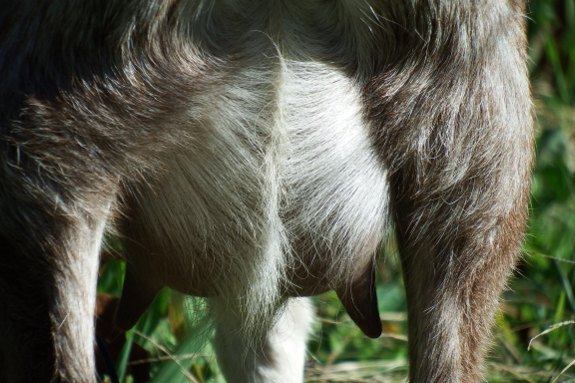
Since we're now sure that
Artemesia doesn't have a bun in the oven, I socked away a couple of
quarts of milk for Thanksgiving pies, then started drying Abigail off.
She's currently producing a little less than two cups a day during once-daily milkings, so I felt confident that she'd survive the cold-turkey method.
The scientists say that stopping milking all at once is actually the
gentlest on your goat since letting her udder fill up without relieving
the pressure halts milk production very quickly. In contrast, if you
ease that pressure, you're setting back the dry-off process so she has
to go through the discomfort all over again. With a medium-to-low
producer like Abigail, I don't worry too much that just stopping milking
will do harm to her udder, so cold turkey it is.
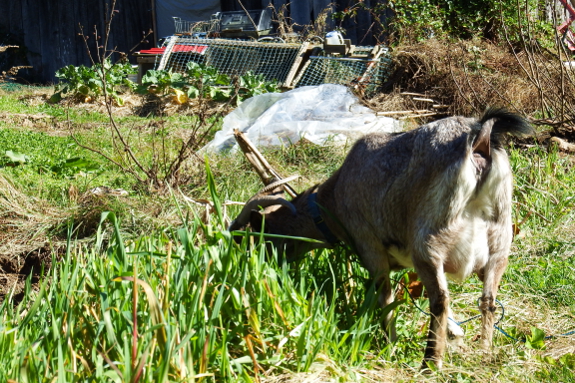
Actually, in a perfect
world, we would have started drying our goat off two weeks ago by
downgrading her food supply to simple hay. But, the weather mostly did
that for us when it nipped back all of the happy wild foods and reduced
our goats' diet to hay plus a bit of daily oats and honeysuckle. I still
give Abigail daily concentrates (about two cups of alfalfa pellets plus
a cup of butternut squash, carrots, and/or sweet potatoes), though, so I
hope that won't gum up the works of her dry-down.
The other factor I took
into account when deciding when to stop milking was Abigail's heat
cycle. Her milk production always drops by about a quarter when she's in
heat, and she cries like the world is coming to an end during that
time. I figured I'd doubly depress her and hope she gets over both
discomforts fast.
I'll keep feeling her udder every morning in search of lumps or heat
that could mark mastitis, but I have high hopes she'll start reabsorbing
the milk soon. We'll miss our homegrown dairy. But like most farm
products, it's best to enjoy what's currently in season. More brussels
sprouts, kale, and lettuce for us!
One advantage of being a small goat is the ability to walk on top of fences.
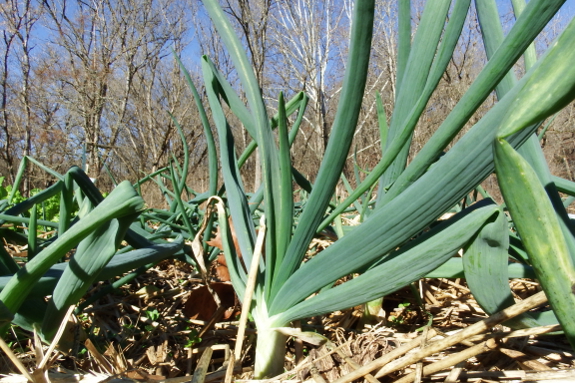
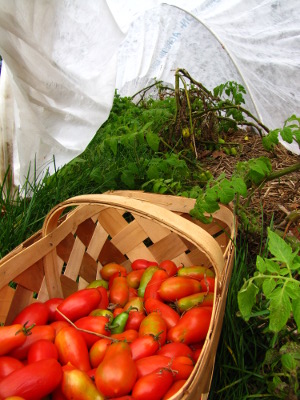 The great thing about row-cover fabric is that it's breathable, so you can
cover crops even when you're enjoying beautiful sunny days. But there
are always so many tasks involved in putting the garden to bed for the
winter that I tend to wait to erect our quick hoops until we absolutely have to. But when exactly is that?
The great thing about row-cover fabric is that it's breathable, so you can
cover crops even when you're enjoying beautiful sunny days. But there
are always so many tasks involved in putting the garden to bed for the
winter that I tend to wait to erect our quick hoops until we absolutely have to. But when exactly is that?
The first time to
consider erecting quick hoops is just prior to your first frost. If the
forecast says you might get a light freeze followed by a week or more of
summer weather, it's often worth protecting at least a few tomatoes
and peppers in hopes of extending the harvest. Sometimes you get lucky
and can eke out summer crops this way until Thanksgiving! But for the
last several years, our first frosts have been killing frosts --- down
into the mid twenties. At that temperature, a row cover isn't enough to
protect tropical vegetables, so I don't even try to cover them up.
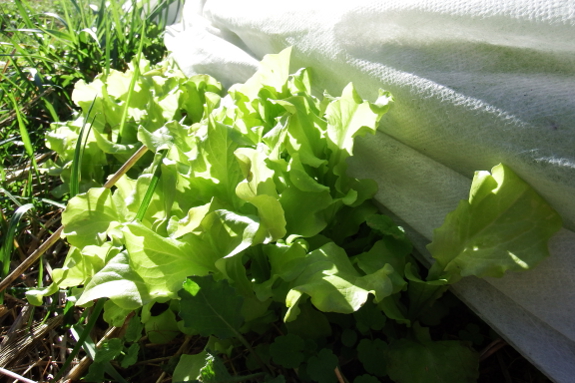
The next most sensitive
crop is baby lettuce. While most fall vegetables require planting so
early that they're mature and hearty by frost time, leaf lettuce can be
eaten as little as month after planting. So I seed our last bed in early
October, then protect those seedlings during even the lightest freezes.
As you can see in the photo above, I'm sometimes lazy and simply lay a
piece of row-cover fabric over this baby-lettuce bed, turning it into a
quick hoop later when the other leafy greens need protection too.
Which brings me to the
main event --- erecting the quick hoops that allow us to eat leafy
greens all winter some years. In this case, it's not so much a single
hard freeze that will harm your crops as extended cold weather. For
example, Friday night dropped down to 21, but I only saw very minor
damage on a few uncovered lettuce leaves and no other harm in the winter
garden. On the other hand, once we begin to see freezes every night,
it's time to cover up the older lettuce, the kale, and any other leafy
greens you want to be harvesting after the winter solstice. I'll
probably put up our quick hoops this week just to be on the safe side.
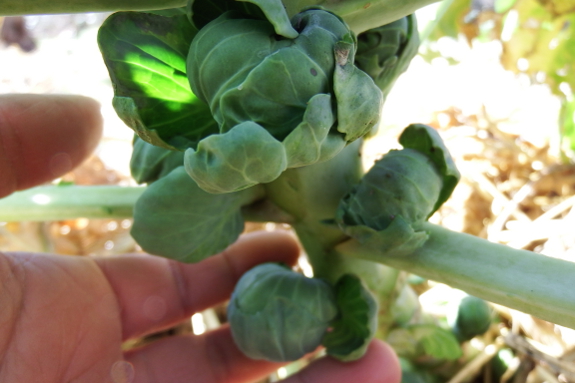
How about brussels
sprouts? In the past, we haven't covered these plants at all since my
goal is for the plants to produce through November and December and then
be eaten up when deep freezes hit in January and February. Some of our
plants are running behind schedule this year, though, so I might cover
them up and see if we can extend the season. That's where Mark's tipi-tunnel experiment will come into play.
The fall garden produces so much bounty for so little work that I
consider it low-hanging fruit...as long as you get the timing right. So
mark your calendars now --- start planting leafy greens in August, cover
them in October or November, and your winter meals will look 100%
brighter all winter long.
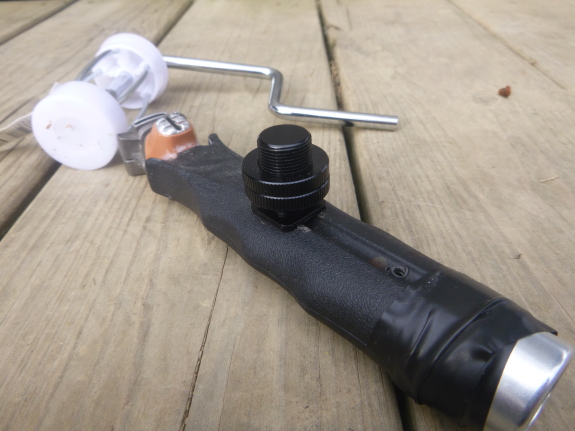
This DIY boom pole adapter
was made from a mini-roller
and a mic
hot shoe adapter.
Cut the roller part off the
handle and cover the jagged edge with something soft.
Drill a 1/4 inch hole in the
top groove of the handle and use a 2 inch 1/4 bolt to attach the hot
shoe which is where the shock mount screws onto.
It's now ready to mount on any extendable
paint pole.
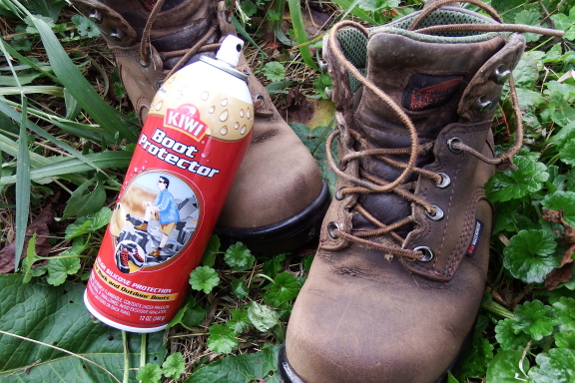
I've been pretty impressed by how well the Kiwi Boot Protector did at rewaterproofing my 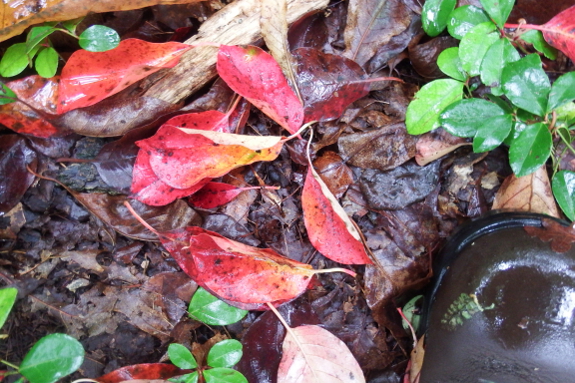 old boots. But two coats (the recommendation on the can) didn't seem quite enough after years of neglect.
old boots. But two coats (the recommendation on the can) didn't seem quite enough after years of neglect.
So after a round of soggy digging,
I scrubbed the boots off, set them in the sun for a few hours, and
sprayed them again. My goal is dry feet even if I take it into my head
to go on another eleven-mile hike in the rain. During that adventure, I brought along two spare pairs of socks and six plastic grocery bags and still came home with wet feet. Next time, my boots will stay dry!
We retired our first set of
Fall broilers today.
These Red
Ranger hybrids seems to be a huge step up from Cornish
Cross.
The biggest chicken of today
weighed in at 5.5 pounds!
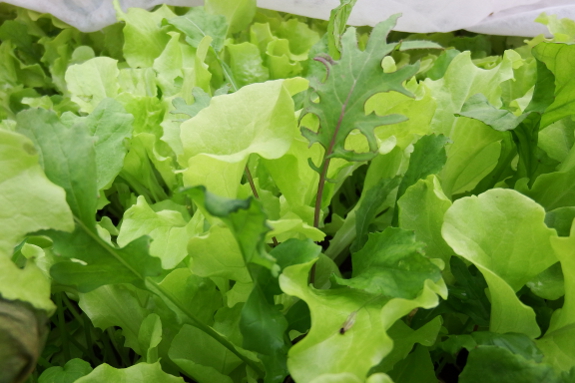
I've played around with mixing salad greens all in the same bed
before and wasn't entirely pleased with the results. Black-seeded
simpson simply trumps all other lettuces in terms of flavor in my
opinion, so mixing in other lettuce varieties wasn't a hit. Meanwhile,
trying to interplant spinach was problematic since lettuce and spinach
grow quite differently.
But this year I randomly
sprinkled a thin line of arugula seeds down the middle of my last
lettuce bed before scattering the lettuce seeds across the entire
surface. Meanwhile, unbeknownst to me, some of the kale I'd let go to
seed in that bed had dropped propagules that were waiting for the proper
season in which to grow. The result? A perfect salad-in-a-bed --- 90%
lettuce, 3% red Russian kale, and 7% arugula. Yum!
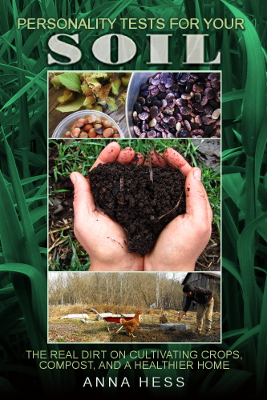 "Why do I have to wait eight months for The Ultimate Guide to Soil if you've already sent the finished version to your publisher?"
"Why do I have to wait eight months for The Ultimate Guide to Soil if you've already sent the finished version to your publisher?"
I know what you mean --- I'm impatient too! Unfortunately, paper books take months to format and print.
On the other hand, ebooks
are speedy. So I'm polishing a quarter of my soil book at a time and
releasing each volume in ebook format. The first one --- Personality Tests For Your Soil
--- goes live January 5...and if you snag it during the first week of
preorder, the price will be only 99 cents! Here are the links:
Seven weeks instead of
eight months --- sounds like a more feasible wait, doesn't it? And this
way you can start putting what you learn into effect in time to improve
your yields for the 2016 gardening year. Thanks in advance for giving it
a read!
We first noticed Monarch
butterflies passing through about a week ago.
This guy showed up today
running a little behind schedule.
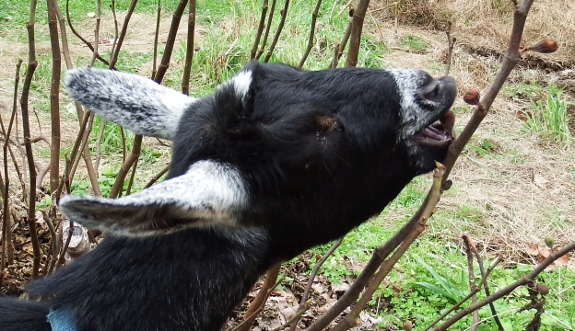
We live on the edge of the fig-growing region, even if you choose a super hardy variety. So it was no big surprise that both of our trees died back to the ground last year despite being swaddled in leaf-filled tarps.
That said, I got to wondering whether my trees might not be a little more winter hardy if I 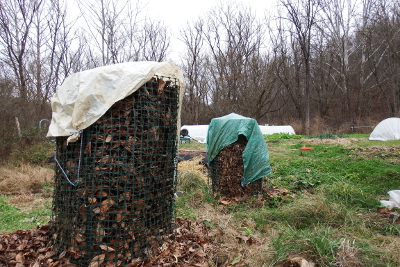 made 100% sure they hit full dormancy before they were covered. So rather than protecting our figs right around the time of our first frost,
I instead waited a solid month until every leaf had drifted to the
ground. Then I let Artemesia pluck off all of the baby figs to make sure
they wouldn't promote fungal growth where I didn't want it. (Yes, my
darling doeling really will eat the figs and not the bark...if I stand
there with my hand on her leash and mind her.)
made 100% sure they hit full dormancy before they were covered. So rather than protecting our figs right around the time of our first frost,
I instead waited a solid month until every leaf had drifted to the
ground. Then I let Artemesia pluck off all of the baby figs to make sure
they wouldn't promote fungal growth where I didn't want it. (Yes, my
darling doeling really will eat the figs and not the bark...if I stand
there with my hand on her leash and mind her.)
Then, finally, I
cut back the trees to a few main trunks, built an enclosure to fill
with leaves, and topped the whole thing off with a tarp apiece. It's
a long shot, but maybe the top growth will survive this winter and give
us the larger, early crop rather than just a few late figs in October.
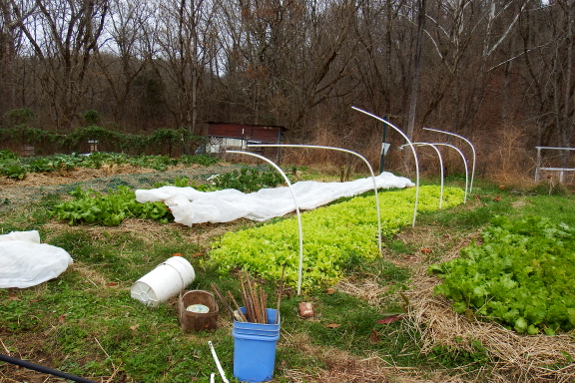
The obvious purpose of quick hoops is freeze protection.
However, I also find it useful to split up the garden into use-now and
use-later areas by covering up the latter. Usually, out of sight, out of
mind is a bad thing in the garden. But when you're stockpiling food for
year-round use, a hidden harvest waiting for you in December can be a
plus.
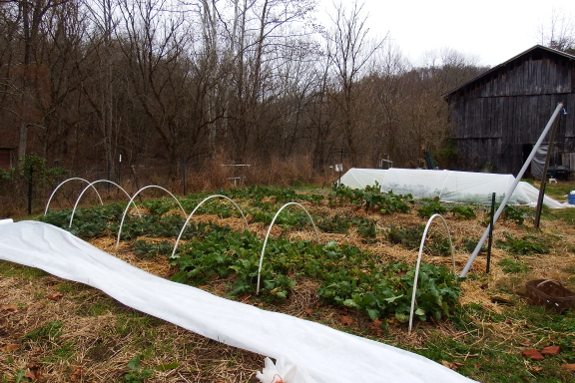
To that end, I covered
1.25 rows of kale, one row of lettuce, then about half a row of parsley
and a quarter row of mustard greens Tuesday. If Mark's tri-tunnel
works out, that'll sock away another row of kale and most of a row of
brussels sprouts. A full winter feast! And we have roughly the same area
left uncovered for November harvest. This is such a bountiful time of
year.
We retired out last Red
Ranger of the year today.
He happened to be the biggest
of the flock at 5.7 pounds.
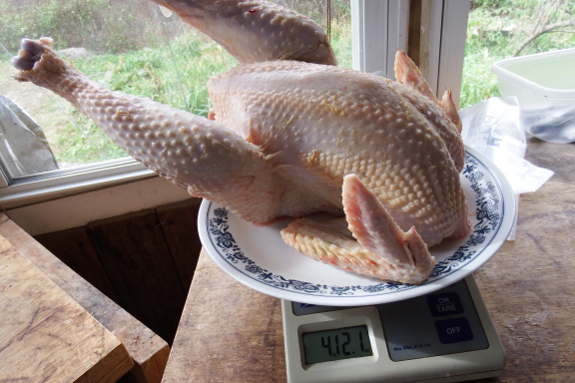
A couple of you asked for more information on Mark's first Red Ranger butchering post. In case you missed it, I commented with lots of stats here.
The only additional bit
of information is the final weight after butchering all sixteen birds.
The lightest bird was 3 pounds 13.5 ounces, the heaviest bird was 5
pounds 12.8 ounces, and the average weight was 4 pounds 13.3 ounces.
Most were so big I had to cut the legs off before packing them away in
gallon ziploc bags!
I really enjoyed working
with this breed, despite it being a hybrid, and I'm pretty sure we're
going to give them another go next year. I think we'll start a few weeks
earlier, though, so the birds aren't finishing off after the killing
frost. And we might also kill them a couple of weeks younger since I
suspect the feed-to-meat ratio
got considerably worse during their last few weeks of life. The
broilers also got a lot lazier about foraging during that period,
meaning they were packing away more bad fats and fewer good fats --- yet
another reason to kill them young.
But, all told, I now think Red Rangers are a good compromise between the fast growth and good conversion ratio of the Cornish Cross and the better foraging and survivability of the heirloom bird.
Right now, if someone asked me which broiler to raise on pasture next
year, I'd feel confident saying "Red Rangers all the way!"
This morning I woke up to the
sound of gunfire.
Anna shot a small buck just
past our blueberry bushes. That's 5 for her to my 1.
We spent the morning
butchering which was easier than times in the past thanks to a new pulley
and gambrel system. Thank you Mom and Jayne.
It took a few minutes to
figure out but really made raising and lowering easy.
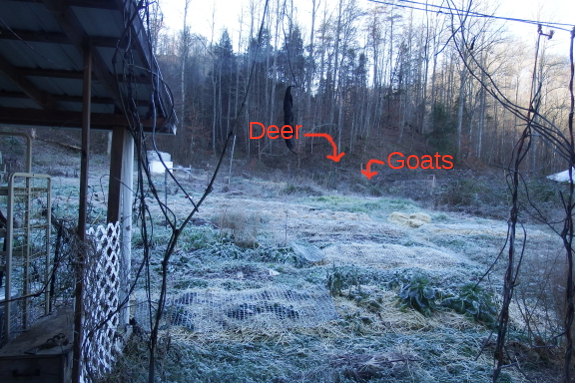
I "hunted" our 2015 deer
from the couch and shot the button buck through the front window. The
hardest part was waiting for the goats to move out of the way so I was
positive I wouldn't injure anyone I cared about via friendly fire.
We're finally starting to
become old hats at butchering a deer, so there's not much to say other
than --- Thank you, Jayne, for the awesome gambrel! Instead, here are some stats for those of you keeping track at home.
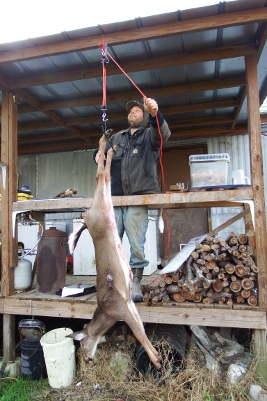 All-time scores:
All-time scores:
- Mark: 1.5
- Anna: 4.5
Yearly totals:
- 2009: 1
- 2010: 0
- 2011: 2
- 2012: 1
- 2013: 1
- 2014: 0 (Heavy acorn year; deer barely came into the garden.)
- 2015: 1
Venison as percent of annual meat consumption:
- about 8%
Amount of damage deer do to our garden compared to their food value:
- Roughly even, trending toward us getting more food from the deer than the deer get from us in recent years
There's still time for us
to bag another deer this year, and we certainly wouldn't mind the
additional delicious, pastured meat. But I've found that once either-sex
rifle season starts in earnest, the critters get much wilier and I can
no longer hunt them from the trailer. For example, my neighbors on one
side tell me they've already killed five deer so far this year, and I
suspect the neighbors on the other side are equally productive. A pretty
average year here in deer-central, where hunters fill their freezers in
November to feed them all year long.
2015 is gonna be the year we stop letting hot air escape out the back door.
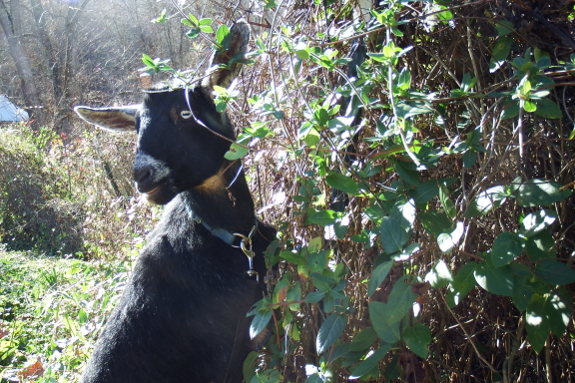
We've been writing a lot
about dead animals lately, so I figured you might enjoy seeing some live
ones. Here's Artemesia eating honeysuckle...just because.
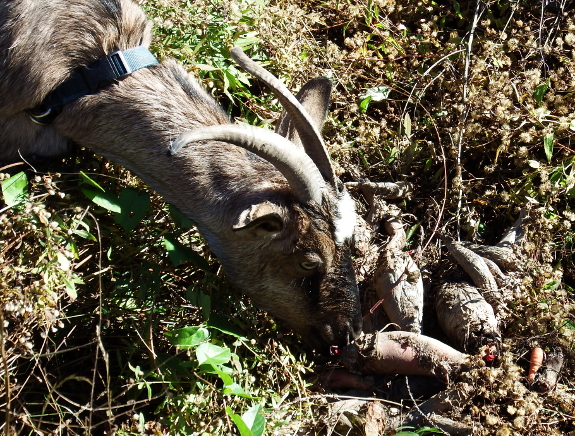
What was Abigail up to when that picture was taken? Straining to get to a pile of discarded mangels that I'd pulled out of the fridge root cellar when she refused to eat even aged, carefully chopped mangels.
"But you hate mangels!"
"Nope, love 'em."
"But these have been frozen and thawed and frozen and thawed so they're half rotten."
"Yup, love 'em."
I really don't understand goats.
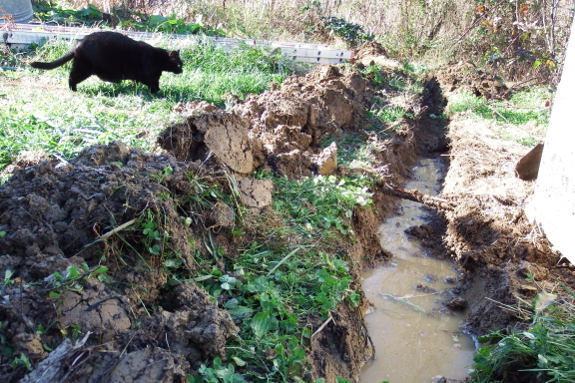
Well, I guess I do understand goats. If you think of them as vegetarian cats with hooves, everything becomes much clearer.
Speaking of cats, Huckleberry's inspecting my drainage ditch in the
photo above. Summer gardening season hit before I finished burying the
overflow pipe for our IBC rain barrel,
so I'm just now finishing up the project. Good news is --- our tower
handled the weight of the heavy rain barrel with no problems and the
ground behind the trailer did become significantly drier as a result.
Bad news is...well, there isn't really any bad news, except for me being
so slow to finish the overflow pipe.
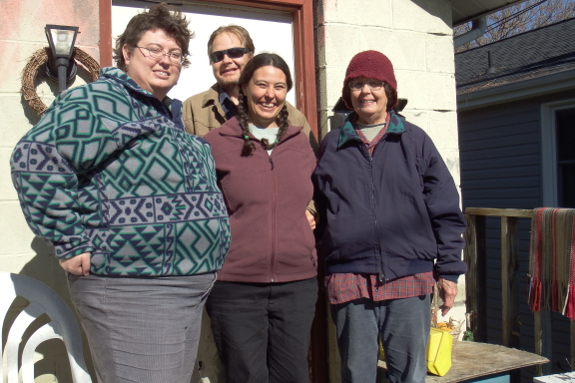
I wore Mark out driving in a huge loop through multiple big cities today, so I'm stealing his posting spot to make up for it.
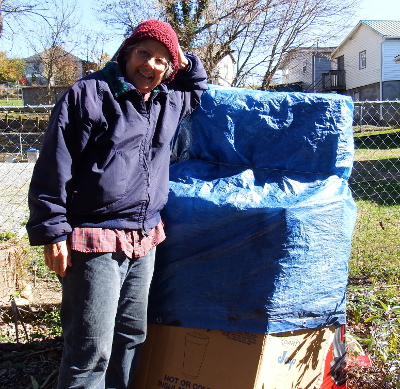 First
stop --- Thanksgiving feast part one with the Bristol clan. I
particularly liked seeing Mom's frost-protected fig tree. Hers produced
quite a few more figs than ours this past year, either because of her
warmer city location or her impressive insulation job.
First
stop --- Thanksgiving feast part one with the Bristol clan. I
particularly liked seeing Mom's frost-protected fig tree. Hers produced
quite a few more figs than ours this past year, either because of her
warmer city location or her impressive insulation job.
Next stop --- stocking up on groceries for our Thursday feast. (More on that in tomorrow's post.)
Then home at last to rest up for the second day of Thanksgiving --- pie day!
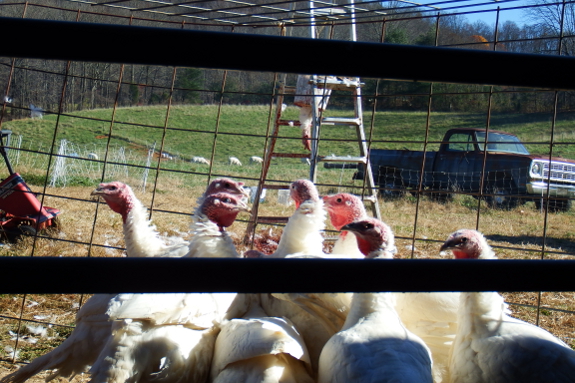
Monday was turkey pickup day. Our friends
let us drop by early so we'd be sure to get home before dark, which
means we got to see the whole butchering operation in action.
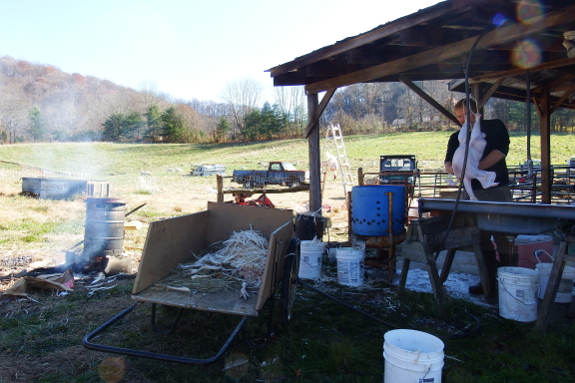
The farmers apologized
profusely because...the turkeys are too big this year! "That's good,
right?" I asked. "More money for you?"
"No," they answered. "We have to give people a discount to get them to take the bigger 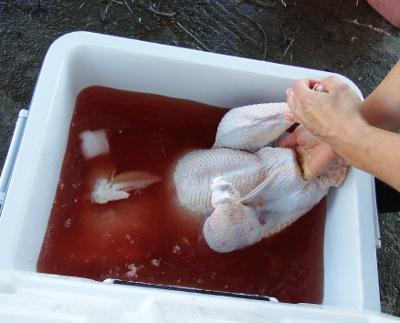 birds since most folks don't know what to do with leftovers."
birds since most folks don't know what to do with leftovers."
"I love leftovers," I replied. "Give me the bird that's going to be the hardest to move."
They hemmed and hawed.
"You really don't want that one. We can't really sell it. It has a bit
of skin torn on the back due to the plucking process...."
"Looks a lot better than some of our birds," I answered. "Hand it over."
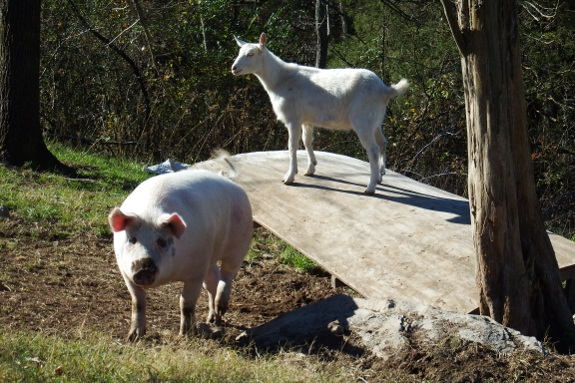
By way of apology, they
offered a pack of last year's bacon. I think I know who got the sweeter
end of that deal. Thanks for the awesome pastured meat!
(Moral of the story: If you're buying meat or produce from a real farmer
and don't mind a few cosmetic blemishes, you'll make their day if you
tell them so. Americans eat with their eyes, and delicious grub can be
hard to move if it has a spot. You'll probably get a discount too!)
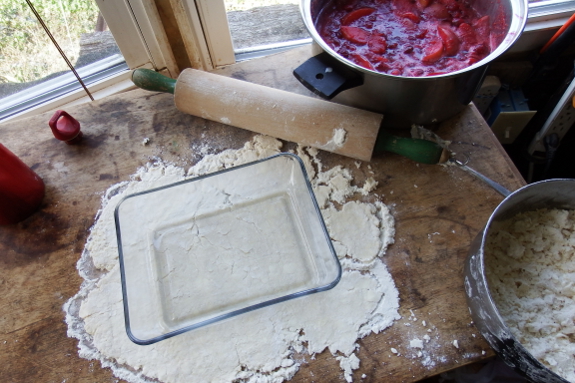
Every fifteen years or so, Mom pulls a 1974 Good Housekeeping
article out of her hat and makes me read it. I wish I could share the
whole thing, but it's still under copyright, so I'll just sum it up with
the title and subtitle:
The story is written by my great-aunt Ruth Tirrell
and tells about the feast her great-grandmother and great-aunts made
for city relatives returning to the Rhode Island farm around 1885. And
each time I read the story, I see something entirely different. This
year's gem was the fact that the family relished potatoes, onions,
turnips, and parsnips...but considered carrots only good enough to feed
to cattle.
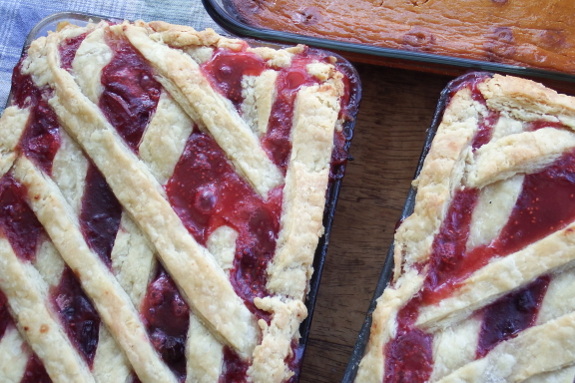
I think I can probably sneak in another little quote about pies without being sued:
The family joining me
tomorrow is much smaller than my great-great-great grandmother Mary
Greene's massive clan. So I figure we'll get by with a 9x13 butternut
pie and two deep-dish cranberry-apple-raisin pies. But I followed the
family tradition of making dessert ahead to beat the rush. Pumpkin-type
pies, especially, taste better on the second or third day!
(And thank you to my pie consultant, Joey, for deciding on the dessert menu.)
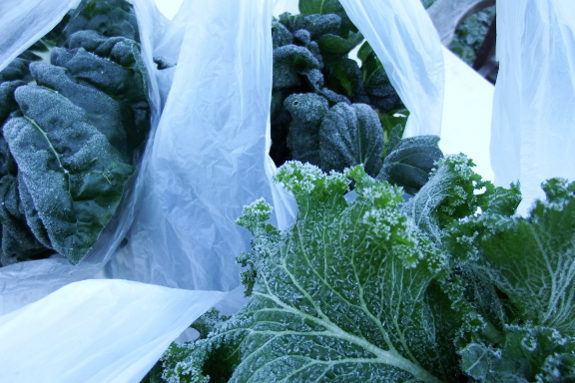
Mustard, Swiss chard, and kale freeze all the time in the garden. They thaw out and keep on growing.
But what happens if you pick frozen leaves and bring them into the kitchen to cook later?
Answer: The greens turn into goo. Edible if cooked right away, but not really up to snuff.
Moral: Pick your Thanksgiving greens now and put them in the fridge for tomorrow's feast!
Abigail pounded on her door
this morning until it busted open.
I knew when I first heard
about the new pounding last week it would be a matter of time before
something more heavy duty was needed.
The solution was to replace
that beefy screen door latch with a heavy chain.
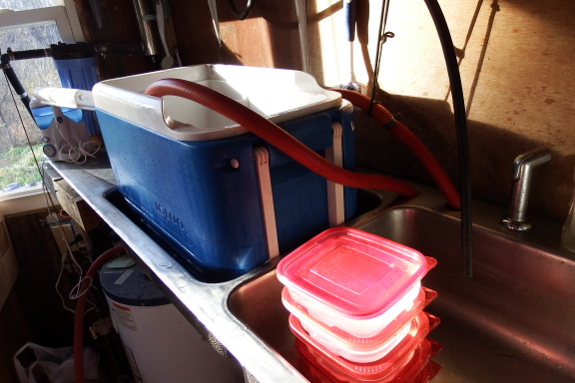
"You'll probably want to brine your turkey," my pastured-poultry producer said when we picked up our 22-pound beast.
I've brined lots of chickens, but my mind drew a blank when I tried to imagine how to keep a tremendous turkey cool while submersing it in a bath of salt water. But the answer is simple --- brine in a cooler.
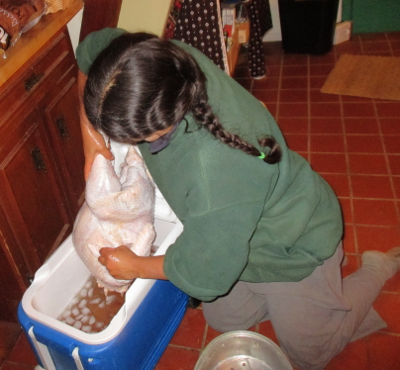 Step
one --- scrub that cooler to within an inch of its life. After cleaning
ours thoroughly, I also soaked the cooler in bleach water for a couple
of hours just in case, then let it dry overnight to fully kill any bad
critters. At the same time, I filled some tupperware containers with
water and tossed them in the freezer to create homemade ice packs.
Step
one --- scrub that cooler to within an inch of its life. After cleaning
ours thoroughly, I also soaked the cooler in bleach water for a couple
of hours just in case, then let it dry overnight to fully kill any bad
critters. At the same time, I filled some tupperware containers with
water and tossed them in the freezer to create homemade ice packs.
Next, I mixed salt and
water and poured the combination into the cooler along with lots of ice.
And the turkey of course! Put on the lid and your bird will tenderize
in cool safety for eight to sixteen hours.
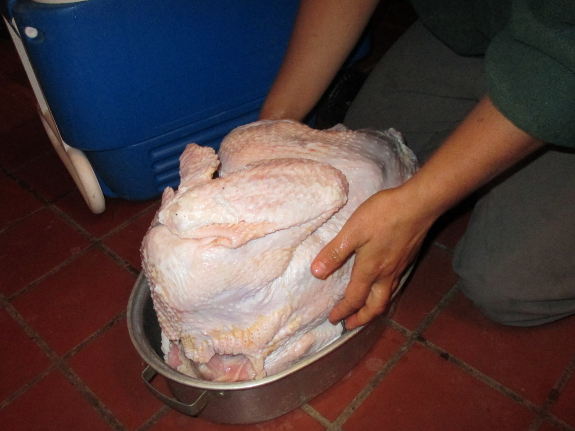
Next step, remove the
turkey from the brine and let it air dry uncovered in the fridge
overnight. This step is necessary if you want crisp, rather than soggy,
skin. We decided the easiest way to do this was to put the turkey in the
roaster....which didn't work until we turned the humongous bird
sideways.
Then roast and enjoy. Have a great Thanksgiving!
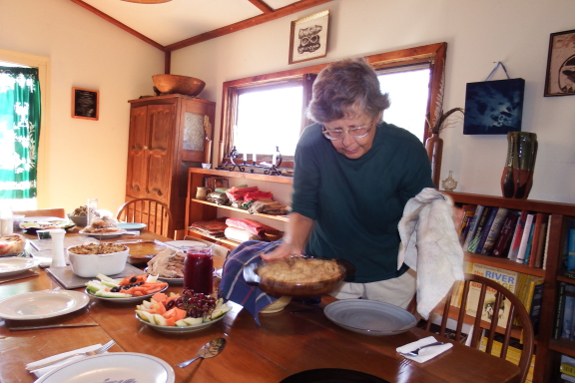
Thanksgiving --- feasting, family, and fun.
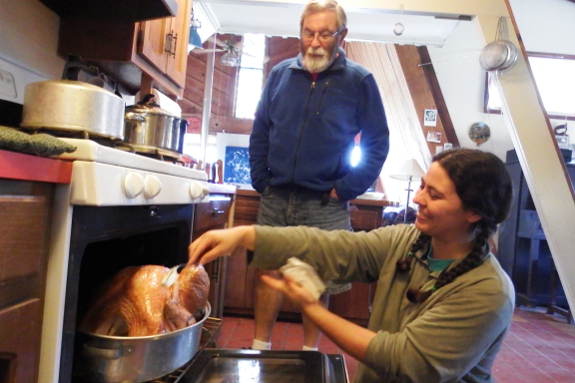
I outsourced much of the turkey to my father, not wanting to be responsible if it was imperfect. Despite both of our best efforts, the beast did end up imperfect...but it didn't matter.
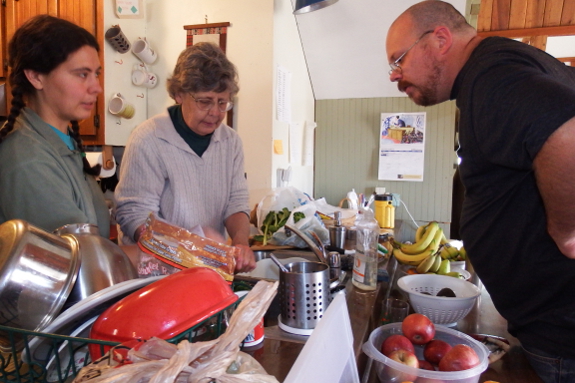
Our focus was on the food. But, honestly, I think we had the most fun pulling together to put each dish on the table.
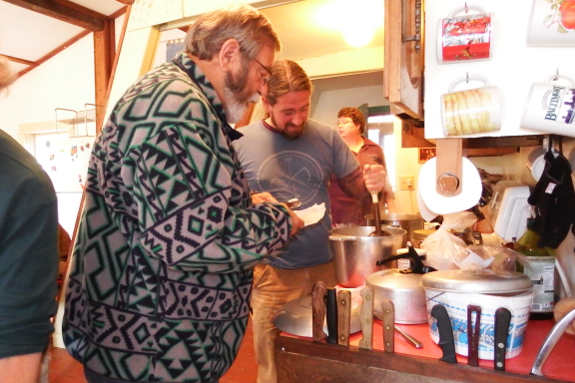
For example, my nephew Jeremiah saved the day by figuring out how to mash the potatoes with the implements in the communal kitchen.
The space was well-stocked in every other regard, but we couldn't for
the life of us find any kind of masher or beater. Pure elbow grease did
the job in the end.
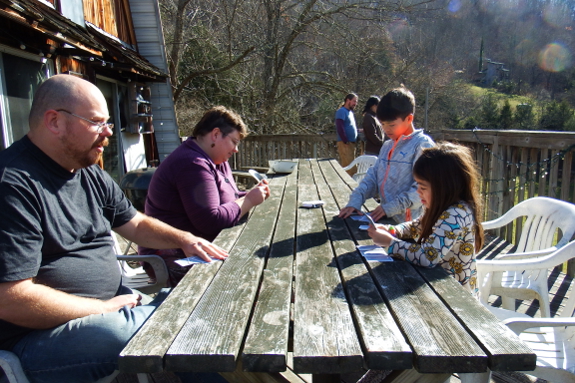
Meanwhile, Maggie kept the kids busy playing our family favorite card game --- Boot.
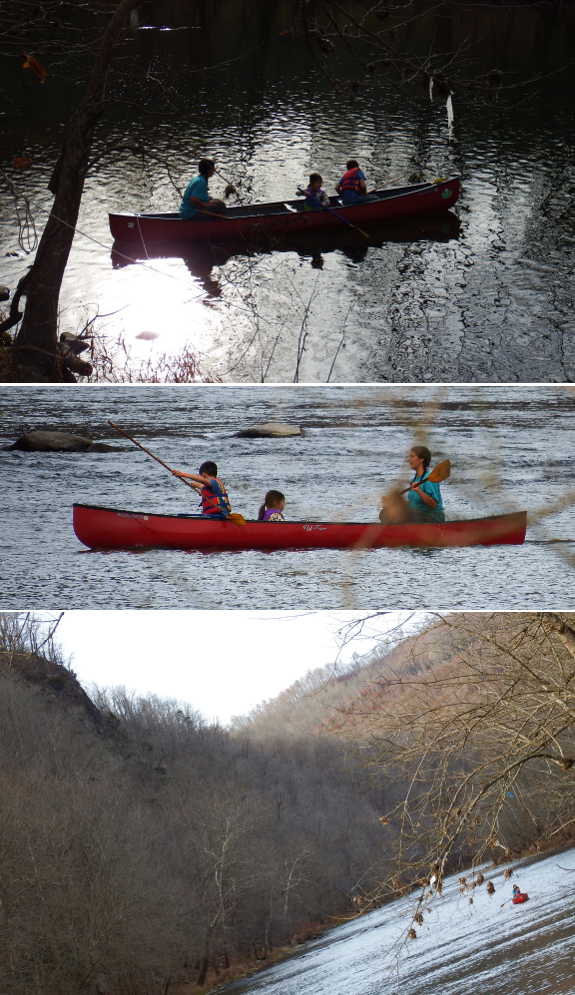
After the meal, it was so
sunny and warm most of us gravitated toward the river. I took the kids
out on a canoe trip which matched my definition of success --- no one
fell in.
Then I went home to decompress with the goats. For an introvert, six hours with nine people is a lot of visiting. But after a good night's sleep, I'm ready to join in the action again today.
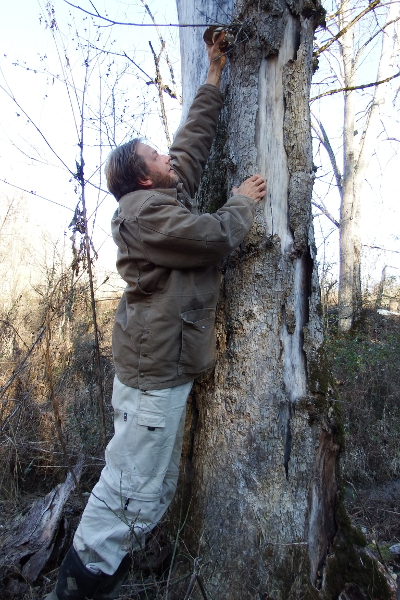 I've filled about twenty pages of a notebook this year with tips and skills I've acquired from my quest to rewire my brain for happiness. It hasn't always worked, but I've definitely been happier than ever before.
I've filled about twenty pages of a notebook this year with tips and skills I've acquired from my quest to rewire my brain for happiness. It hasn't always worked, but I've definitely been happier than ever before.
The most relevant tip for the Thanksgiving season has to do with
gratitude --- one of the five core skills of a happy camper. To play
along at home, don't just tell the world what you're thankful for once a
year around the family table. Instead, you'll get optimal results by
writing down your gratitude once a week. (More often gives diminishing
returns because you tend to go into robot mode and not really focus on
how good you have it.) You'd be surprised how much you'll realize you
have to be thankful for if you keep this practice up!
A similar technique is to focus on wonder and beauty in your daily life.
I've improved both my sleep and my disposition by remembering five
wonderful events of the day before I fall asleep each night. Then (if I
haven't drifted off yet), I move on to anticipation of five wonderful
things about tomorrow. My favorite part about this practice is that you
know you'll need five fun facts to report that night, so you tend to
spend all day taking in the beauty around you.
Why is this relevant to a homesteading blog? I think simplifying your
brain is even more important than simplifying your life style. Because
if you're focusing on wonder and gratitude day to day, then you won't
need a fancy kitchen or new car to fill the void inside. And that lack
of craving is what drives true voluntary simplicity.
We had our first goat date
today.
His name was Monte Cristo,
and it only took a minute of small talk before he got down to business.
Artemesia rode nicely in the
backseat of our car with zero accidents.
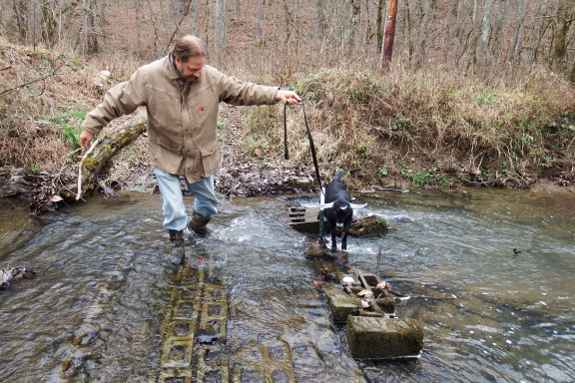
"Phew!" I thought to myself Friday as I walked home in the gloaming. My family and I had spent another long day feasting and walking and canoeing,
then I'd cleaned up the community house and lugged home two gallons of
turkey stock. I was ready to get back to my usual routine.
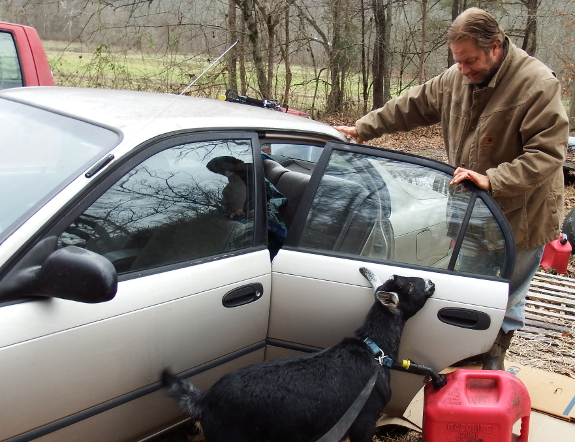
But Artemesia was yelling her head off even though she should have been
sound asleep. And when I pulled out the buck rag Saturday morning, she
wagged her tail like crazy. It was time for our grand adventure.
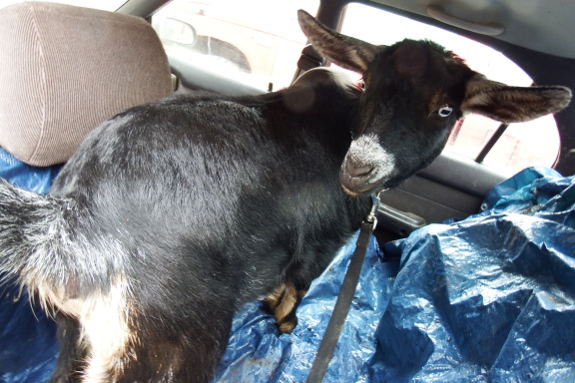
Luckily, I'd chatted with
a local goatkeeper named Tonya three weeks ago and had an open
invitation to bring my doeling to visit one of her three bucks. For the
sake of herd sanitation, she insisted upon a driveway date, but she also
promised me a do-over if the first time failed. So Mark spread the tarp
across the back seat of the car, Artemesia jumped gamely inside, then
we wound down country roads for an hour and fifteen minutes until we
reached Tonya's house.
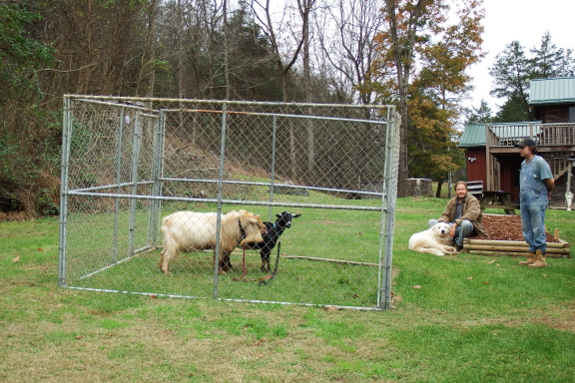
Tonya raises Nigerian
dwarf goats and she recommended her largest stud, Monte, to do the deed.
He's got the best milking lines of the three choices, and he also
turned out to be a gentleman, willing to romance Artemesia until she got
in the mood.
It didn't take long. Our
doeling was pretty much in the mood from the get-go. We watched as he
licked at her pee, licked at her back, licked at his own pee, then got
to work.
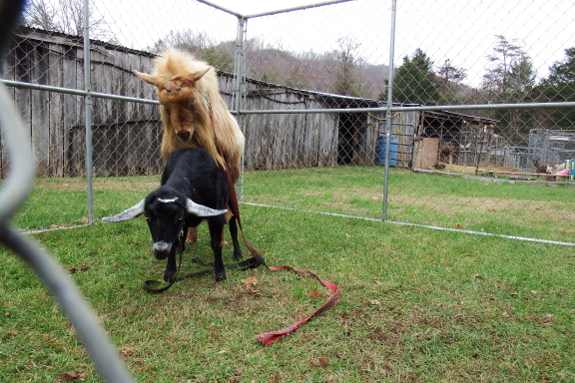
He did the deed a couple
of times, but Tonya wasn't 100% convinced. Despite seeing semen, she
would have liked to also see Artemesia tuck the lower half of her body
down as Monte climaxed.
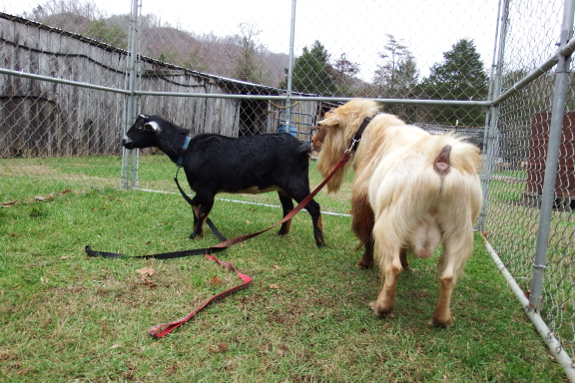
But after a couple of
go-rounds, Artemesia was getting bored with the whole thing. "Been
there, done that," she told us. So we took her home, knowing we'd get
another chance for our $75 if she comes back into heat in December.
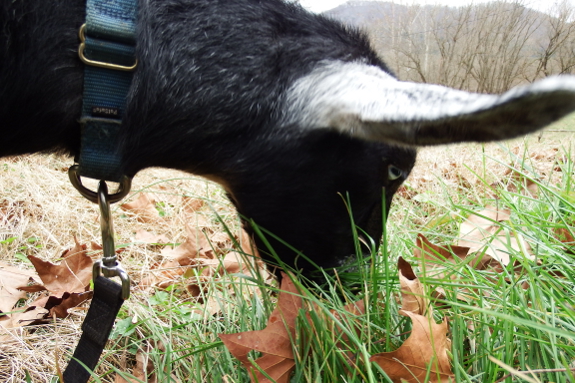
All told, Artemesia's
date went much more smoothly than I'd expected. She was a sweetheart in
the car, Abigail didn't have a fit while her herdmate was gone, and we
all got home by mid afternoon. And, hopefully, I can start calling
Artemesia a first freshener after this instead of a doeling.
Now maybe we can have a restful Sunday with no family or goat dates to pull me off the farm.
Our new pulley and
gambrel system was lacking any kind of decent instructions.
Once I realized the top chrome piece functions like a mini blind it was
easy to adjust the height by pulling up on the load slightly while at
the same time pulling the rope with either a forward or backward motion.
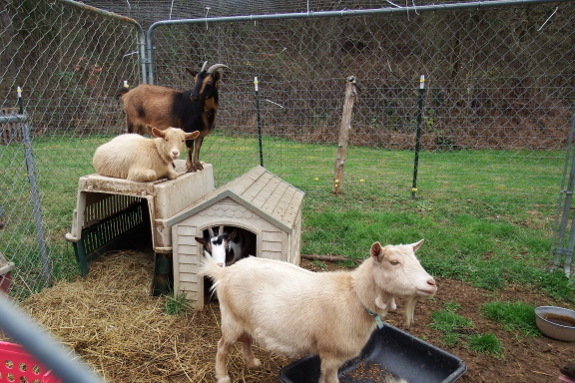
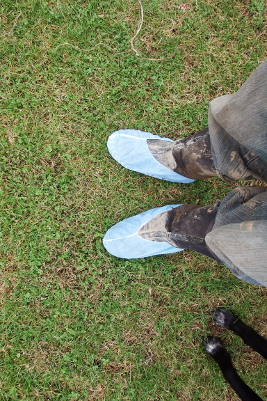 While we were waiting around for Monte to romance Artemesia,
Tonya took me on a tour of her operation. She has about eight happy
does, one of whom is pregnant, plus three bucks. Add in a turkey (whose
mate had recently become dinner), five layers, three young silkies, and
roughly half a dozen dogs, and their homestead was hopping with life.
While we were waiting around for Monte to romance Artemesia,
Tonya took me on a tour of her operation. She has about eight happy
does, one of whom is pregnant, plus three bucks. Add in a turkey (whose
mate had recently become dinner), five layers, three young silkies, and
roughly half a dozen dogs, and their homestead was hopping with life.
Tonya sells most of her
kids, so she's used to folks wanting to tromp around in her pastures. As
a result, she was all set with little medical booties to cover my farm
boots, keeping any diseases I might be tracking in off her farm and any
of her diseases off mine. The booties didn't fit Mark's feet, but he
didn't mind babysitting our doeling while I went on the grand tour.
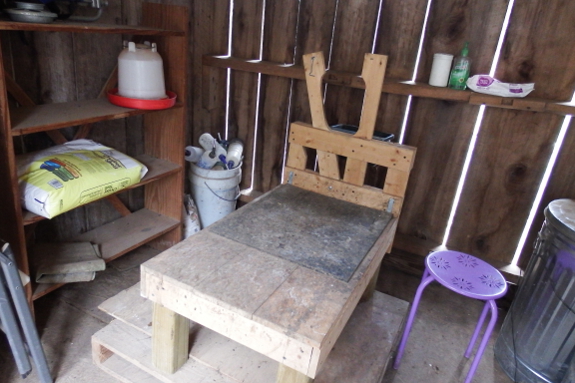
I was particularly taken
by their milking stanchion, which features a side piece that swivels
into place then locks with a latch. Although I like our current stanchion,
Mark considers its design imperfect. So we may eventually upgrade to
something like this when Artemesia begins giving milk in the spring.
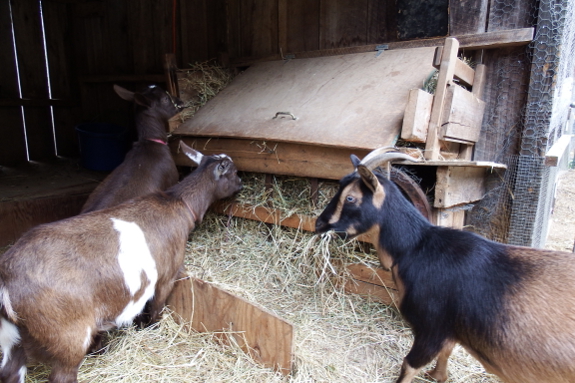
Their manger was just the right size for one bale, but I felt like it allowed for more spillage than ours. No upgrade necessary there!
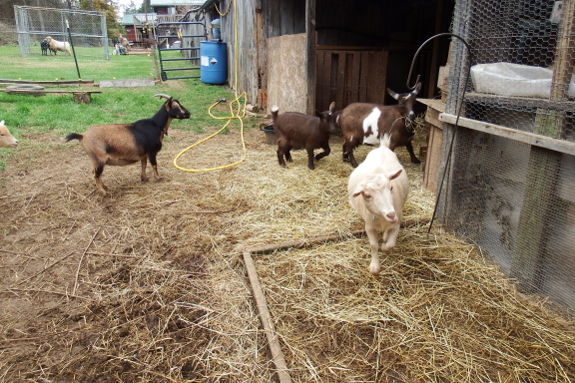
A couple of years ago, I
would have wanted to spend quite a while with these fat and sassy does.
But Artemesia has won over my heart so completely that I dismissed these
perfect specimens as OPG (other people's goats) and moved on. I'd
rather load our first freshener back in the car and wind home to enjoy a
goat afternoon in our own oat fields rather than pet Cocoa Bean and the
other girls whose names had nothing to do with chocolate and were thus
forgettable.
We had to decrease the spring
closing tension on our back door which created the problem of it
blowing open a smidgen when the wind blew really hard during the day when we have it unlocked.
The solution was this magnet
with the easy 1/4 inch mounting holes.
A small Stanley mending plate made a
nice strike plate once I got it lined up exactly where it needed to be.
Want more in-depth information? Browse through our books.
Or explore more posts by date or by subject.
About us: Anna Hess and Mark Hamilton spent over a decade living self-sufficiently in the mountains of Virginia before moving north to start over from scratch in the foothills of Ohio. They've experimented with permaculture, no-till gardening, trailersteading, home-based microbusinesses and much more, writing about their adventures in both blogs and books.
